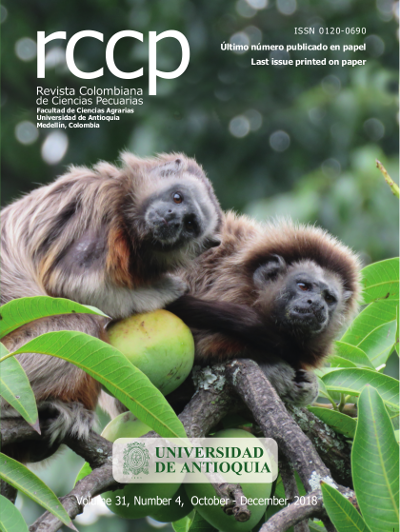Evidence of persistent Mullerian duct syndrome in a Yorkshire terrier
DOI:
https://doi.org/10.17533/udea.rccp.v31n4a08Keywords:
dog, genetics, intersex, karyotype, reproductive diseaseAbstract
Anamnesis: A one-year-old female Yorkshire terrier, weighing 2.2 kg, was referred for evaluation of an abnormal structure in the inguinal region. Clinical and laboratory findings: Upon examination, the structure -similar to a penis- was found protruding from the preputial orifice. Physical, laboratory, ultrasound, and radiographic examinations were performed. The initial suspicion was a case of sexual development disorder, so the dog was referred for exploratory laparotomy and karyotyping. Treatment approach: During the surgical procedure, two macroscopically similar structures were found at the caudal pole of the left and right kidneys. These tissues were attached to two structures similar to the uterine horns, caudally fused to a body in the pelvic cavity. All the tissue was removed and submitted for histopathological examination, revealing the presence of typical seminiferous tubules (testis) and proliferative endometrial glands (uterine tubes). Subsequently, a surgical correction procedure was performed to cover the penile tissue and avoid damage by exposure and contact. Conclusion: This case reports unique information on diagnosis and therapeutic approach in a Yorkshire terrier with persistent Müllerian duct syndrome (PMDS). Because they are unusual, sexual development disorders are challenging in terms of diagnostic and therapy, making this report a valuable tool for veterinarians.
Downloads
References
Borrow RD, Gregory SP, Giejda AA, White RN. Penile amputationand scrotal urethrostomy in 18 dogs. Vet Rec2011; 169:657-665.
Breshears MA, Peters JL. Ambiguous Genitalia in a Fertile, Unilaterally Cryptorchid Male Miniature Schnauzer Dog. Vet Pathol 2011; 48:1038-1040.
Christensen BW. Disorders of sexual development in dogs and cats. Vet Clin North Am Small Anim Pract 2012; 42:515-526.
Fossum TW. Surgery of reprodutive and genital systems. In: Fossum TW, editor. Small animal surgery. 3 ed. Elsevier, Saint Louis. 2008: 702-740.
Hagel T, Baade S, Kirchhoff A , Kuiper H, Perk A. Persistent Mullerian duct syndrome in a Yorkshire terrier. Kleintierpraxis 2010; 55:547.
MacPhail CM. Surgery of the bladder and urethra. In: Fossum TW, editor. Small animal surgery. 4 ed. Elsevier, Saint Louis. 2013: 735-779.
Marshall LS, Oehlert ML, Haskins ME, Selder JR, Patterson DF. Persistent Müllerian duct syndrome in miniature schnauzers. J Am Vet Med Assoc1982; 181:798-801.
Matsuu A, Hashizume T, Kanda T , Nagano M, Sugiyama A, Okamoto Y, Hikasa Y. A case of persistent Müllerian duct syndrome with sertoli cell tumor and hydrometra in a dog. J Vet Med Sci 200; 71:379-381.
Meyers-Wallen VN, Donahoe PK, Ueno S, Manganaro TF, Patterson DF. Müllerian inhibiting substance is present in testes of dogs with persistent müllerian duct syndrome. Biol Reprod 1989; 41:881-888.
Meyers-Wallen VN. Gonadal and sex differentiation abnormalities of dogs and cats. Sex Dev 2012; 6:46-60.
Meyers-Wallen VN. Review and update: genomic and molecular advances in sex determination and differentiation in small animals. Reprod Domest Anim 2009; 44:40–46.
Pavletic MM, O’Bell SA. Subtotal penile amputation and preputial urethrostomy in a dog. J Am Vet Med Assoc 2007; 230:375-377.
Poth T, Breue W, Walter B , Hecht W, Hermanns W, Disorders of sex development in the dog-Adoption of a new nomenclature and reclassification of reported cases. Anim Reprod Sci 2010; 121:197-207.
Vegter AR, Kooistra HS, Van Sluijs FJ, Van Bruggen LWL, Ijzer J, Zijlstra C, Okkens AC. Persistent Mullerian Duct Syndrome in a Miniature Schnauzer Dog with Signs of Feminization and a Sertoli Cell Tumour. Reprod Domest Anim 2010; 45:447-452.
Whyte U, Monteagudo LV, Diaz-Otero A, Lebrero ME, Tejedor MT, Falceto MV, Whyte J, Gallego M. Malformations of the epididymis, incomplete regression of the mesonephric tubules and hyperplasia of Leydig cells in canine persistence of Müllerianduct syndrome. Anim Reprod Sci 2009; 115:328-333.
Downloads
Published
How to Cite
Issue
Section
License
Copyright (c) 2018 Revista Colombiana de Ciencias Pecuarias

This work is licensed under a Creative Commons Attribution-NonCommercial-ShareAlike 4.0 International License.
The authors enable RCCP to reprint the material published in it.
The journal allows the author(s) to hold the copyright without restrictions, and will allow the author(s) to retain publishing rights without restrictions.









